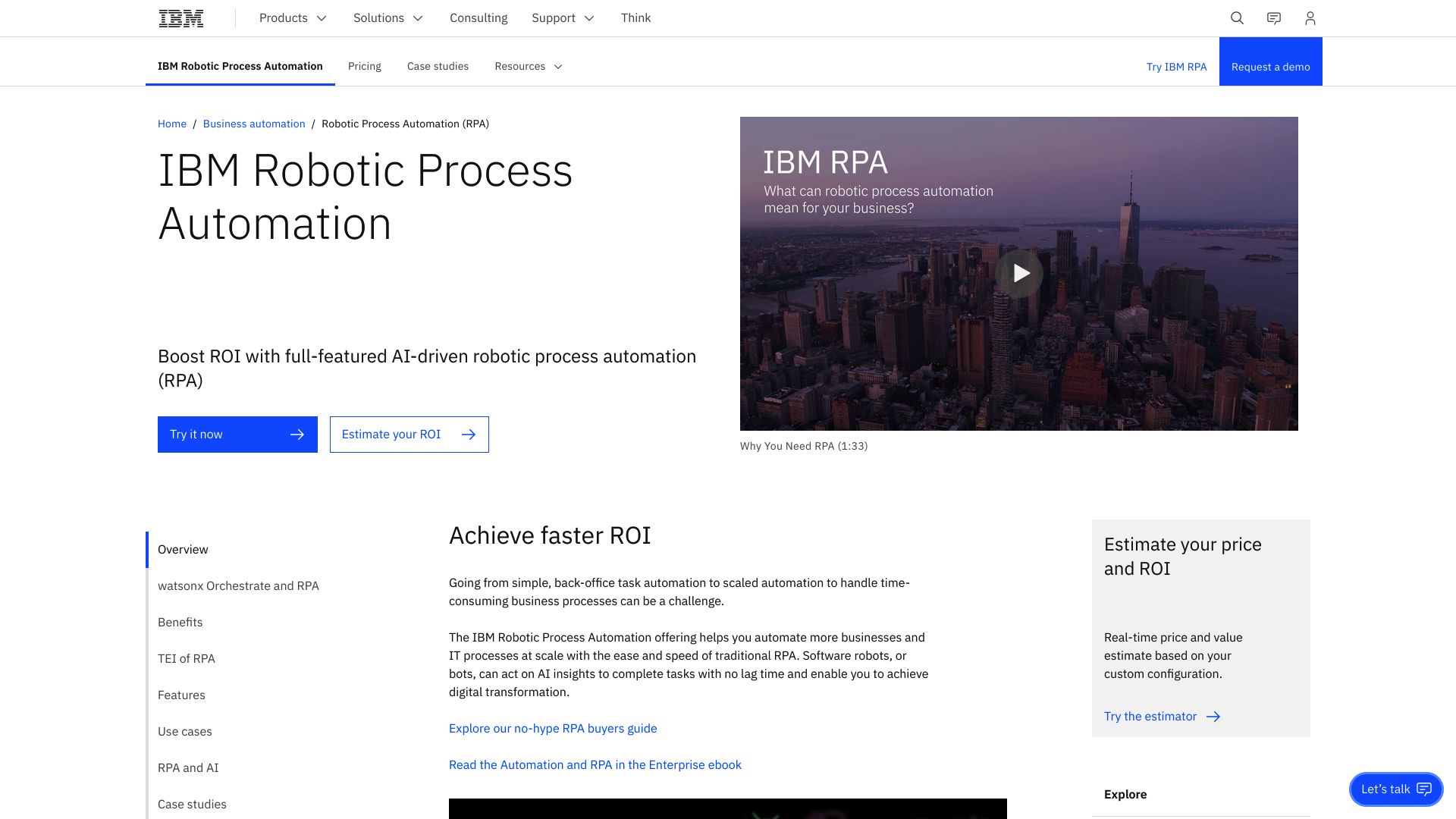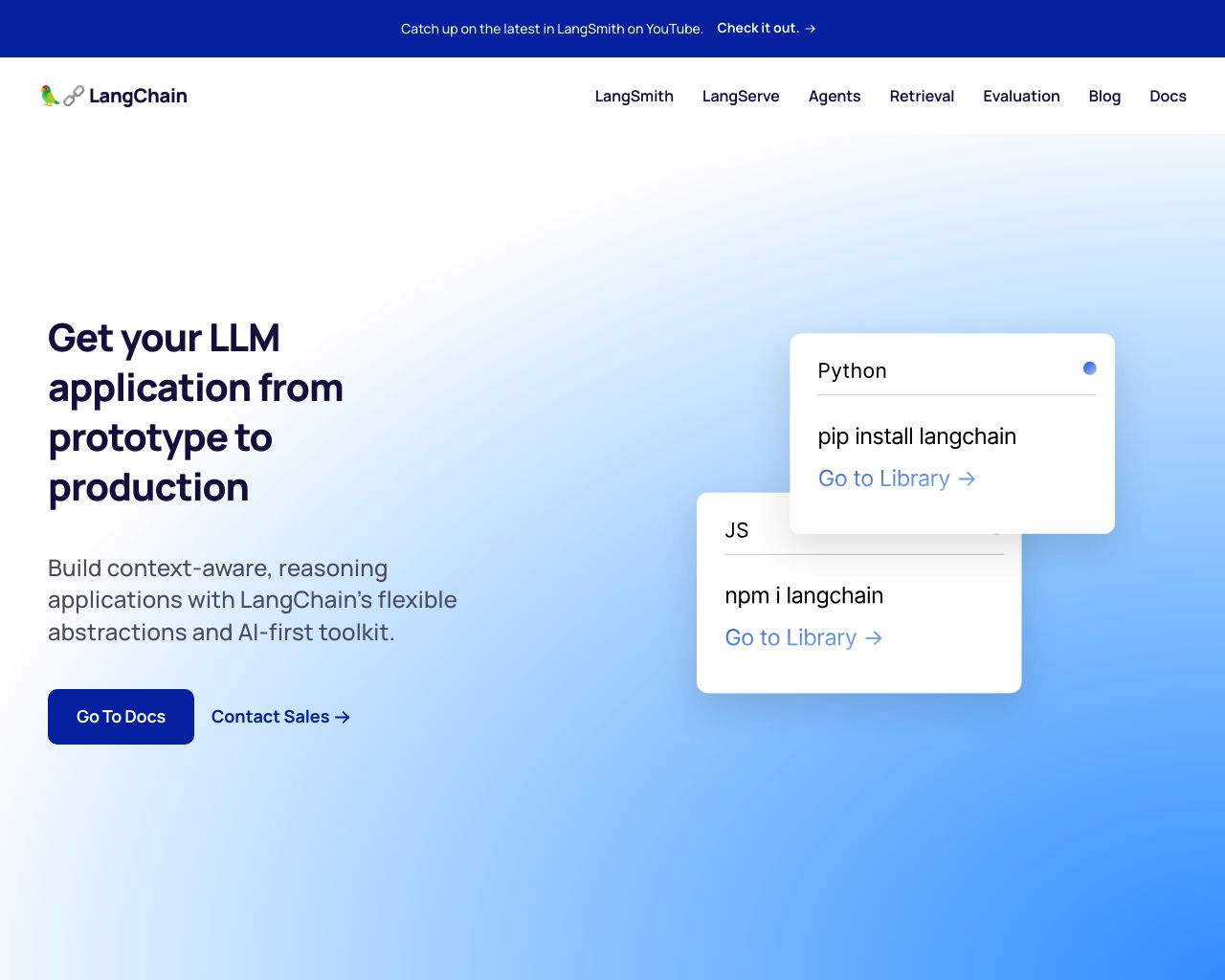IBM RPA vs. LangChain: Comparing AI-Driven Automation Tools
AI-driven automation and development tools are reshaping business processes and application creation. IBM RPA vs. LangChain offer distinct approaches to these challenges, each with unique strengths. IBM RPA excels in enterprise-grade robotic process automation, while LangChain provides a flexible framework for building language model applications.
This comparison explores their key features, use cases, and limitations, helping you determine which solution best fits your organization’s needs. We’ll also introduce SmythOS, a powerful alternative that combines enterprise-level security with AI development flexibility, offering a comprehensive solution for businesses seeking to harness the full potential of AI integration and automation.
IBM RPA Overview
IBM RPA offers a comprehensive suite of tools for automating repetitive digital tasks across enterprise systems. The platform enables businesses to create, deploy, and manage software robots (bots) that mimic human interactions with digital interfaces.


IBM RPA’s core strengths lie in its enterprise-grade capabilities. The platform provides hosted environments for both development and production, allowing teams to build, test, and scale their automation solutions seamlessly. A visual builder with drag-and-drop functionality simplifies bot creation, making it accessible to users with varying technical expertise. This low-code approach accelerates development cycles and empowers business users to participate in automation initiatives.
IBM RPA’s core strengths lie in its enterprise-grade capabilities. The platform provides hosted environments for both development and production, allowing teams to build, test, and scale their automation solutions seamlessly.
Integration stands out as a key feature of IBM RPA. The platform connects with a wide array of enterprise applications, including mainframes, APIs, and desktop software. This versatility enables organizations to automate complex workflows that span multiple systems. Additionally, IBM RPA incorporates AI capabilities through its integration with watsonx Orchestrate, enhancing bots with intelligent decision-making and natural language processing abilities.
While IBM RPA offers robust functionality, its enterprise focus may present challenges for smaller organizations or individual developers seeking a more lightweight solution. The platform’s comprehensive feature set could potentially introduce a steeper learning curve for those new to RPA. Additionally, pricing information is not readily available, which may complicate budgeting and evaluation processes for potential users.
IBM RPA’s security and governance features align well with enterprise requirements. The platform integrates with IBM OpenPages for enhanced transparency and compliance management. This integration facilitates audit logging, access control, and data encryption, addressing critical concerns in regulated industries. However, users should be prepared to invest time in understanding and configuring these advanced security features to fully leverage their benefits.
LangChain Overview
LangChain empowers developers to create sophisticated applications powered by large language models (LLMs). This open-source framework simplifies the entire LLM application lifecycle, from development to deployment. LangChain’s modular approach allows developers to build, test, and launch AI-driven solutions efficiently.
LangChain empowers developers to create sophisticated applications powered by large language models (LLMs). This open-source framework simplifies the entire LLM application lifecycle, from development to deployment.
At its core, LangChain offers a suite of tools for LLM integration. The framework includes LangGraph for building stateful agents, LangSmith for monitoring and evaluating chains, and LangServe for deploying applications as APIs. These components work together seamlessly, enabling developers to focus on creating innovative AI solutions rather than wrestling with infrastructure.
LangChain’s strength lies in its flexibility and extensive integration options. The platform supports various LLM providers, databases, and APIs, allowing developers to customize their applications to specific needs. This adaptability makes LangChain suitable for a wide range of use cases, from chatbots and content generation to complex data analysis and decision-making systems.
While LangChain offers powerful capabilities, its open-source nature means that users must rely on community support and documentation. This can present challenges for newcomers or those seeking enterprise-grade support. Additionally, the rapidly evolving nature of the framework requires developers to stay current with updates and best practices.
LangChain positions itself as a versatile tool for AI development, catering to both individual developers and larger teams. Its modular design and focus on developer experience have garnered a strong following in the AI community. As the field of LLM applications continues to expand, LangChain’s role in simplifying development and deployment processes makes it a notable player in the AI tooling landscape.


Feature Comparison
IBM RPA and LangChain represent distinct approaches to AI-driven automation and development. IBM RPA focuses on enterprise-grade robotic process automation, while LangChain provides a flexible framework for building language model applications.
IBM RPA excels in core enterprise automation features. It offers hosted environments for both development and production, allowing seamless bot creation and deployment. The platform includes robust security measures like data encryption and integration with IBM OpenPages for enhanced governance. However, IBM RPA lacks some advanced AI capabilities found in LangChain, such as direct integration with Hugging Face models or deployment as GPT.
LangChain, on the other hand, shines in its AI development flexibility. It supports a wide range of language models and provides tools for building sophisticated AI agents. LangChain’s LangGraph enables the creation of stateful, multi-agent systems — a capability not explicitly offered by IBM RPA. While LangChain provides powerful AI development tools, it may not match IBM RPA’s enterprise-grade security features or extensive integration with legacy business systems.
Feature Comparison Table
| IBM RPA | LangChain | SmythOS | |
|---|---|---|---|
| CORE FEATURES | |||
| AI Agents | ❌ | ✅ | ✅ |
| Visual Builder | ✅ | ❌ | ✅ |
| No-Code Options | ✅ | ❌ | ✅ |
| Memory & Context | ❌ | ✅ | ✅ |
| Autonomous Agents | ❌ | ✅ | ✅ |
| Explainability & Transparency | ❌ | ✅ | ✅ |
| Multimodal | ❌ | ✅ | ✅ |
| Problem-Solving Capabilities | ❌ | ✅ | ✅ |
| Multi-Agent Collaboration | ❌ | ✅ | ✅ |
| Work as Team | ❌ | ✅ | ✅ |
| Agent Work Scheduler | ✅ | ❌ | ✅ |
| SECURITY | |||
| Constrained Alignment | ❌ | ❌ | ✅ |
| OAuth | ❌ | ✅ | ✅ |
| IP Control | ❌ | ❌ | ✅ |
| COMPONENTS | |||
| Foundation AIs | ❌ | ✅ | ✅ |
| Huggingface AIs | ❌ | ✅ | ✅ |
| Zapier APIs | ❌ | ❌ | ✅ |
| Classifiers | ❌ | ✅ | ✅ |
| Data Lakes | ❌ | ❌ | ✅ |
| DEPLOYMENT OPTIONS (EMBODIMENTS) | |||
| Deploy as Webhook | ❌ | ❌ | ✅ |
| Staging Domains | ❌ | ❌ | ✅ |
| Production Domains | ❌ | ❌ | ✅ |
| API Authentication (OAuth + Key) | ❌ | ✅ | ✅ |
| Deploy as Site Chat | ❌ | ✅ | ✅ |
| Deploy as Scheduled Agent | ✅ | ❌ | ✅ |
| Deploy as GPT | ❌ | ✅ | ✅ |
| DATA LAKE SUPPORT | |||
| Hosted Vector Database | ❌ | ❌ | ✅ |
| Sitemap Crawler | ❌ | ❌ | ✅ |
| YouTube Transcript Crawler | ❌ | ❌ | ✅ |
| URL Crawler | ❌ | ❌ | ✅ |
| Word File Support | ✅ | ❌ | ✅ |
Best Alternative to IBM RPA and LangChain
SmythOS emerges as the superior alternative to IBM RPA and LangChain, offering a comprehensive agentic AI automation platform that combines the best of both worlds. Our solution bridges the gap between enterprise-grade automation and flexible AI development, providing a user-friendly yet powerful environment for creating and deploying AI agents.
Unlike IBM RPA’s focus on traditional robotic process automation, SmythOS empowers users to build sophisticated AI agents capable of autonomous decision-making and problem-solving. Our visual builder and no-code options make AI development accessible to a wider audience, while still offering the depth and flexibility that experienced developers crave.
SmythOS provides a complete ecosystem for AI agent development and deployment… ensuring seamless scalability and integration with existing systems.
In contrast to LangChain’s framework approach, SmythOS provides a complete ecosystem for AI agent development and deployment. We offer hosted environments for both development and production, ensuring seamless scalability and integration with existing systems. Our platform supports a wide range of AI models and integrations, including Hugging Face and Foundation AI models, giving users the flexibility to choose the best tools for their specific needs.
SmythOS stands out with its unparalleled ease of use and extensive feature set. Our drag-and-drop interface allows for rapid prototyping and iteration, while our advanced components like classifiers and data lake support enable the creation of sophisticated AI solutions. Unlike IBM RPA and LangChain, SmythOS offers native support for multimodal interactions, allowing agents to process and respond to various types of input, including text, voice, and images.
With SmythOS, the possibilities are truly unlimited. Whether you’re building a customer service chatbot, automating complex business processes, or developing cutting-edge AI applications, our platform provides the tools and flexibility to bring your vision to life. By choosing SmythOS, you’re not just selecting a tool – you’re investing in a future-proof solution that will grow and adapt with your AI needs.
Conclusion
IBM RPA and LangChain offer distinct approaches to automation and AI development, each with its own strengths. IBM RPA excels in enterprise-grade robotic process automation, providing robust security features and seamless integration with legacy systems. LangChain, on the other hand, shines in its flexibility for AI development, supporting a wide range of language models and offering tools for building sophisticated AI agents.
While both platforms have their merits, SmythOS emerges as the superior choice, combining the best of both worlds. Our platform offers enterprise-level security and scalability akin to IBM RPA, while matching LangChain’s flexibility in AI development. SmythOS goes further by providing a user-friendly drag-and-drop interface, making advanced AI functionalities accessible to users with varying technical expertise.
SmythOS stands out with its comprehensive feature set, including multimodal capabilities, problem-solving prowess, and support for multi-agent collaboration. Our platform’s “Create Once, Deploy Anywhere” approach allows for seamless integration across various environments, from chatbots to APIs. With over 300,000 integrations available, SmythOS offers unparalleled versatility in connecting with existing tools and systems.
For those looking to harness the full potential of AI in their workflows, we invite you to explore our diverse range of AI-powered agent templates. These templates cover multiple business categories and are designed to streamline processes across various functions. To experience the power of SmythOS firsthand, create a free account and start building AI agents with no time limit. Unlock the future of workforce automation and revolutionize your approach to AI integration with SmythOS.
Last updated:
Disclaimer: The information presented in this article is for general informational purposes only and is provided as is. While we strive to keep the content up-to-date and accurate, we make no representations or warranties of any kind, express or implied, about the completeness, accuracy, reliability, suitability, or availability of the information contained in this article.
Any reliance you place on such information is strictly at your own risk. We reserve the right to make additions, deletions, or modifications to the contents of this article at any time without prior notice.
In no event will we be liable for any loss or damage including without limitation, indirect or consequential loss or damage, or any loss or damage whatsoever arising from loss of data, profits, or any other loss not specified herein arising out of, or in connection with, the use of this article.
Despite our best efforts, this article may contain oversights, errors, or omissions. If you notice any inaccuracies or have concerns about the content, please report them through our content feedback form. Your input helps us maintain the quality and reliability of our information.
